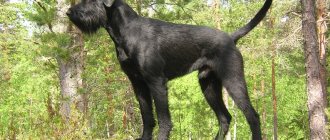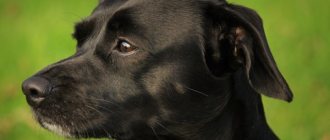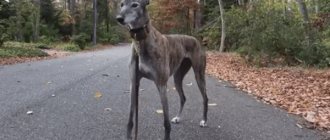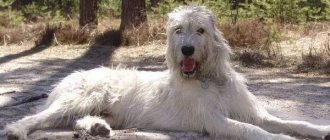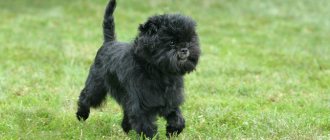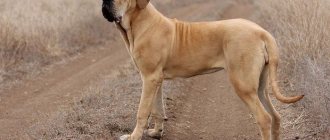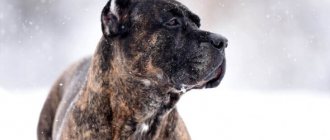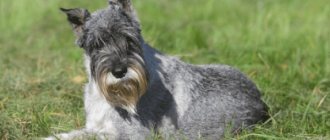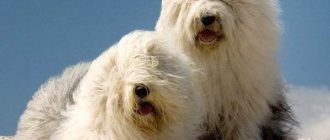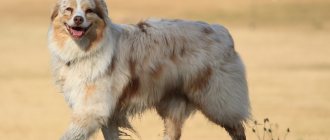- Giant Schnauzer
The Giant Schnauzer is a working dog originally from Germany. They can be a loyal and courageous companion. They were used to drive livestock, worked in butcher shops, and even guarded breweries. Giant Schnauzers are very active and agile dogs. If you are looking for a loyal and energetic companion, this is the dog breed for you.
- Country of origin : Germany
- Height at withers : female: 60–65 cm, male: 65–70 cm
- Weight : female: 25–34 kg, male: 27–48 kg
- Lifespan : 12-15 years
- Use : companion dog, shepherd, watchdog, service dog
- Other names : Great Schnauzer
Purchasing a Giant Schnauzer puppy is a responsible and important act that you need to think carefully about before doing. This is especially true for those people who are going to become truly responsible dog breeders. The question of choice should be approached carefully and without haste, comparing your own habits, daily routine and the nature of the chosen breed. When the future owner has decided on the breed, a new dilemma arises: how to find a bona fide breeder? Here you need to be extremely careful not to become a prematurely disappointed dog owner.
Buying a Giant Schnauzer puppy is a very exciting event, because you can say that a new family member will appear. To ensure that the event does not overshadow anything, it is worth taking a responsible approach to choosing a breeder. There are no bad dog breeds; you can simply run into an unscrupulous breeder for whom money comes first. The future owner is at great risk of buying an animal that has a lot of health problems. It is for this reason that you need, first of all, to get to know the breeder well, read reviews about him and the like.
History of the Giant Schnauzer breed
Giant Schnauzer
The ancestors of Giant Schnauzers were typical peasants who did not have a narrow professional specialization, and therefore they were used for a long time as dogs “for everything.” Herding sheep flocks, guarding farmsteads, protecting the owner and his property - Giant Schnauzers coped well with all these types of activities, which is why they earned the respect of the German peasantry. The breed is especially widespread in southern Germany, as well as in the border areas of Austria and Switzerland. Stingy Bavarian farmers quickly realized that such versatile pets could be used for any kind of dog work and rushed to increase their numbers.
As for the true origin of the “giant faces,” everything is very, very vague. Moreover, the degree of relationship between Giant Schnauzers and Middle Schnauzers has not been fully clarified. All that is known for sure is that at some point the genes of pinschers merged into both breeds. But exactly when this happened and with whose help is almost impossible to establish today.
By the middle of the 19th century, large-faced dogs began to gradually appear in the world. In particular, the first purebred Giant Schnauzers can be seen in portraits of the Bavarian Princess Elizabeth, as well as in images of other important people of that time. Animals began appearing at cynological events in 1902, but breeders' real interest in the breed arose only in 1909, after 29 Giant Schnauzers were presented to guests at a Munich exhibition.
At first, the dogs were dubbed Munich Schnauzers, but people have adopted several alternative nicknames for them. For example, German burghers preferred to call the animals beer schnauzers, since the owners of Bavarian eateries often delivered their foam products to them. The breed received its modern name only in 1923, along with an official appearance standard.
In the USSR, they learned about the existence of Giant Schnauzers in the 20s of the 20th century, but no one dared to seriously breed them. Specialists from the Krasnaya Zvezda nursery were able to correct the situation. In the early 70s, two purebred littermates were delivered to the School of Service Dog Breeding - Akbar f. Raacksee and Anni f. Raakzee, who later became the great-grandmother and great-grandfather of all Russian Giant Schnauzers.
Breed characteristics and character
Dogs of this breed appeared in Germany. There are many rumors and speculations associated with their occurrence, but none of them have been proven. According to one version, the relatives include herding dogs, and according to another, hunting dogs.
The references say that the dog was listed in the south of the country as a driver of pack animals and guarded livestock. At the end of the first quarter of the twentieth century, the dog was officially recognized as a working dog. In addition, for quite a long time the dogs guarded taverns from intruders, which is why they were nicknamed “beer” schnauzers.
Sometimes the Giant Schnauzer is compared with a black terrier, or, in other words, Stalin's dog. There are almost no differences between them if both are shorn. Therefore, it is difficult for non-professional dog walkers to recognize who is who. But the difference will not go away from the eyes of experienced breeders.
In our country, animals gained mass popularity in the mid-90s of the last century, and then interest in them began to decline. But the reasons for this phenomenon are not entirely clear, since the breed does not have many disadvantages. All of them are covered by positive character traits.
Schnauzers are good companions and very loyal companions; they have enormous patience and a perky disposition. They are considered very balanced dogs. They are loyal to children and can play with them for a long time. Capable of protecting their owner.
At the same time, they do not touch strangers without special reason. In childhood they can be disobedient, but this feature is easily corrected by training and education. In general, the dog is distinguished by prudence, perseverance and good immunity. In addition, Risen adapts perfectly to any climatic conditions.
Appearance of a Giant Schnauzer
The Giant Schnauzer is a muscular, mustachioed and bearded breed with well-developed muscles. Today, this is the largest variety of schnauzer of all existing ones (middle and miniature schnauzers are distinguished by more modest dimensions). The height of the average Rizen male varies between 60-70 cm, and its weight should not exceed 47 kg.
Head
Giant Schnauzer puppy
The Giant Schnauzer has an elongated skull with a flat forehead and no pronounced occipital protuberance. The muzzle is wedge-shaped, not pointed. The stop is embossed.
Jaws and teeth
All representatives of the breed have strong, strong jaws with a full dental formula (42 teeth) and a scissor bite.
Nose
The bridge of the nose is smooth, without dips. The lobe is black, large, with large nostrils.
Eyes
The Giant Schnauzer's eyes are small, dark, and set straight. The eyelids are close to the eyeball.
Ears
The high-set, moderately drooping ears of the Giant Schnauzer have a classic triangular shape. The front edge of the ear should touch the dog’s cheekbones, the optimal height of the fold of the ear flap is at the level of the skull. Previously, ears were cropped for aesthetic purposes. Today, the procedure is prohibited in most European countries, although most domestic breeders continue to practice it.
Neck
The Giant Schnauzer has a slender, graceful, but at the same time very muscular neck without skin folds. In the area of the nape, the cervical vertebrae form a slight bend.
Giant Schnauzer muzzle
Frame
The body of the Giant Schnauzer is quite compact with a short, strong back and a convex, deep lumbar region. The sides and belly are tucked together, which gives the dog’s silhouette an extra slim look. The croup of purebred individuals should be slightly sloping, and the chest should not be too wide and slightly protruding forward, beyond the shoulder joints.
Limbs
Running Giant Schnauzer
The Giant Schnauzer has straight, moderately wide legs. The shoulder blades are of an inclined type with good muscles, the elbows are pressed to the body. The hind limbs of purebred animals should be pulled back. Welcome: wide, sufficiently long hips, normal knees without obvious turning in or out, and cat-type (arched) paws.
Tail
Saber-shaped, normal length. Like the ears, the tail of Russian Giant Schnauzers is often docked.
Wool
The Giant Schnauzer's coat is hard and has a wire-like feel to the touch. The coat is of a double type, consisting of abundant undercoat and coarse, not very long hair. The coarsest and longest hair grows on the dog’s face, forming expressive “whiskers” and “eyebrows.”
Color
Giant Schnauzer pepper and salt color
The officially recognized types of colors are black and the so-called “pepper and salt”.
Defects and disqualifying defects
Any deviation from the breed standard is already a defect, but if the defect is not very pronounced, the exhibition commission can turn a blind eye to it. But owners of animals with twisted elbows, a lightweight body type and straightened hocks should not count on such concessions.
Disqualifying faults of Giant Schnauzers:
- deviations from a scissor bite (overshot, undershot, jaw distortion);
- insufficient/excessive growth (with a deviation of 4 cm or more in any direction);
- congenital deformities and pathologies;
- inappropriate behavior (unreasonable cowardice, aggression, suspicion);
- inconsistency with the breed type;
- defects in physique, color and coat.
Photos of the Giant Schnauzer
Personality of the Giant Schnauzer
Giant Schnauzers are hard workers, you can't look for them. True, it is worth making a reservation here: the Risen will work only for the benefit of the owner who managed to prove to them his own worth. In general, leadership is in the breed’s blood, which is why representatives of this canine clan enjoy a reputation as difficult-to-train creatures. Starting from the first days of life, the Giant Schnauzer respects only himself and those who are stronger and more cunning, so think about whether you can maintain your own authority in the eyes of your pet 24 hours a day throughout his life. Dogs have a very warm relationship with children. Most Giant Schnauzers are not averse to running after restless little ones and participating in harmless pranks. There are also plenty of exceptions to the general rule, but in general animals are not inclined to show aggression towards those whom they initially consider weaker and, needless to say, stupider than themselves.
Giant Schnauzer with a child
One can write endlessly about the energy of the breed. Giant Schnauzers are fast, tireless and capable of moving with lightning speed from a sleeping state to full combat readiness. Getting your dog mad if you are a stranger is not that difficult. All you have to do is raise your voice a little at its owner or touch him in a not very friendly manner. All! Get ready to repel the attack of the furious four-legged guard, who saw you as the main criminal of all times. And yet the passion for performing official duties does not turn the “Bavarians” into boring, ferocious crackers. Quite the contrary, at home, Giant Schnauzers are quite sweet and good-natured. Moreover, with the right training methods, they can easily curb their own impulsiveness and gambling.
By nature, Giant Schnauzers are very inventive and cunning and enjoy using these qualities in everyday life. They will happily fool their own owner if he allows it, so you will have to constantly keep your finger on the pulse with this breed. The curiosity and sociability of Giant Schnauzers should not be discounted. For normal development, mustachioed “Bavarians” simply need to have maximum contact with their owner, learning the science of conducting an adequate dialogue. If you get a Giant Schnauzer in the hope that he will just sit in the corner, guarding your wealth, you have chosen the wrong breed.
Character and behavior
Giant Schnauzers are versatile service dogs with phenomenal guarding qualities. They are distinguished by a calm, self-possessed and patient disposition and perfectly combine activity and obedience. Giant Schnauzers recognize only one person as their owner, but are friendly to all family members.
Dogs are wary of strangers, but do not show causeless aggression. True, if the Rizens feel that the owners are in danger, they will immediately come to their defense.
With proper training, Giant Schnauzers can easily control their own gambling. But if dogs are constantly indulged, they will not miss the opportunity to take advantage of their innate ingenuity and will become cunning. Therefore, Giant Schnauzers are not suitable as a first pet for unprepared owners with a gentle character.
Breed and children
Despite their large size and serious nature, Giant Schnauzers get along well with children. Smart and patient dogs stoically endure all childish pranks and gladly take part in joint active games. Savvy characters understand perfectly well that children can be intrusive and forgive them a lot.
True, this does not mean that children do not need to be explained that dogs should not be offended or pulled by the beard.
Breed and other animals
Discreet and patient, Giant Schnauzers get along well with cats and other dogs. They perceive all pets as members of the pack and do not offend them. True, the goodwill of the Rizens does not extend to rodents. Especially considering that German farmers used schnauzers to kill rats.
Education and training
Giant Schnauzer training
Whatever activity you involve Giant Schnauzers in, they will always demonstrate excellent results. Take a child for a ride on a sled, threaten a thief who is encroaching on the owner's property, or save a drowning man - properly trained Rizens can do everything and a little more than that. However, almost all representatives of this glorious family can boast not only a high level of intelligence, but also an outstanding degree of stubbornness, which is why experts classify the Giant Schnauzer as a breed that requires early training. Moreover, according to an experienced trainer and author of the book “Giant Schnauzer”, Rüdiger Bludau, “giant little faces” will have to be trained throughout their entire lives because they are thinking and erudite animals, from whom it is impossible to raise blind executors of their master’s will.
The qualities that every owner must strive to develop in their Giant Schnauzer are restraint and obedience. Never encourage a puppy to bark at strangers. The breed's character is already hot-tempered, so sudden outbursts of aggression are best extinguished at a young age. Training is easy for Giant Schnauzers, but the animals will still try to play leader, so take yourself seriously during classes. It is better to conduct lessons in a playful way with mandatory encouragement at the end. But first, take your pet for a walk so that he can burn off his energy and become more focused. Giant Schnauzers also do not like to work on a full stomach, so do not feed your puppy before training. If during training the dog shows cunning, do not rush to scold it; on the contrary, try to quietly bypass the traps it sets. But if your ward stubbornly ignores commands, you should think about it. Most likely, the Giant Schnauzer is testing your authority. Perform such a trick once or twice, and you can forever forget about the hope of raising a well-mannered dog.
Owners of show-class animals will have to pay increased attention to their socialization. Exhibition animals should calmly tolerate the touch of strangers and not growl at the approaching groomer. You can combat the breed’s wariness by walking your pet in crowded places and near busy highways, as well as traveling with it on public transport. Introduce the Giant Schnauzer to the ring in advance. This type of leash is not the most dog-friendly design, so putting it on your dog too late can cause him to panic and develop a lifelong aversion to such things. You should walk the Giant Schnauzer in the ring carefully, making sure that he does not tighten the noose around his neck. As for practicing the show stance, the handler cannot do without rewarding treats that will help keep the dog in the correct position.
Pros and cons of the breed
Giant schnauzers are serious working dogs, and it is better to learn about their advantages and disadvantages before purchasing a puppy.
| pros | Minuses |
| Spectacular appearance | Need for grooming |
| No shedding | The need for special training |
| Developed security qualities |
Giant Schnauzers are large dogs with a representative appearance and a serious character. They easily learn new commands, but are ready to obey only those who can become an indisputable authority for them.
Maintenance and care
Despite their not-so-tiny dimensions, the “Bavarians” do not take up much space in the house and do not turn it upside down. It is quite possible to raise a well-mannered apartment dweller from a Giant Schnauzer, provided that you do not deny the animal long walks and active games in the fresh air. And yet, a more acceptable housing option for working breed dogs remains the yard of a private house, where the animal can move freely and have contact with people.
In your favorite chair
Be sure to consider the option of shelter from bad weather for your yard pet. For example, an outdoor enclosure for a Giant Schnauzer must have a canopy and a plank floor on which an insulated booth with a removable roof and a snow flap is installed. If the winters in your region are harsh, you can install electric heating in your pet’s home, but during periods of severe frost it is better to take the dog indoors. The same rule applies to older animals. Giant Schnauzers who have celebrated their 8th birthday are better off spending the night indoors on damp, cool nights. Otherwise, get ready for cold kidneys, aching joints and other consequences of hypothermia.
Putting a Giant Schnauzer on a chain is a real mockery of his pride and temperament. If there is an urgent need to temporarily limit the dog’s habitat (for example, during the arrival of a large number of guests), close it for several hours in an enclosure or house.
Hygiene
The Giant Schnauzer has an amazing coat: thick, dense, repels water and dirt and perfectly protects the dog from minor injuries. Moreover, the well-groomed and clean fur of the “Bavarians” does not have the smell of a dog. There is an opinion that Giant Schnauzers shed differently than most other breeds and that their coat does not shed. In fact, if you deliberately do not take care of your pet, then it will lose dead hair with the same intensity as mongrel dogs, so the only way to avoid tufts of wool flying around the apartment is systematic trimming (pinching). The procedure can be carried out manually, grabbing and pulling out tufts of dead hair with your fingers, or using a trimming knife. After the shedding hair has been removed, it is necessary to carefully examine the dog's skin and treat the injured areas with chlorhexidine.
Important: Giant Schnauzer puppies are given their first pinch at 6 months of age.
An alternative to trimming is to use a roller or furminator, which will help remove excess undercoat and dead outer hair (for dogs that do not take part in shows). Giant Schnauzers are trimmed mainly to improve their appearance. Typical haircut pattern: maximum shortening of hair on the ears, throat, back of the thighs and in the groin area. On other parts of the body, the hair is only slightly worked out with thinning scissors. Wash dogs as needed with sulfur or tar shampoos (tar soap is suitable). But it’s better to comb the “Bavarians” more often, first with a sparse comb that breaks up the resulting tangles, and then with a fine-toothed comb.
My Giant Schnauzer
To improve the structure of the Giant Schnauzer's coat, burdock oil is suitable, which is rubbed into the dog's pre-washed and dried hair (not earlier than a week after trimming). Dietary supplements based on chitin and salmon oil have the same effect. To avoid the appearance of fungus, be sure to dry the hair on your pet's face after he has eaten. If the Giant Schnauzer managed to hang fat on its “whiskers,” wash them with soap and then dry them with a towel.
Owners of pepper-colored show animals will have a little more difficult time, since the “beards” of such animals turn yellow when they come into contact with food. You will have to use special whitening cosmetics sold in veterinary pharmacies and grooming salons to remove the unwanted fawn tone. The same problem can occur in black Giant Schnauzers, which often burn out in the sun. It is best to neutralize the resulting red markings on the dog’s “fur coat” with a tinted shampoo.
With the beginning of the swimming season, the Giant Schnauzer's coat will have to be monitored more carefully, so if your pet is accustomed to swimming in a river or pond, then firstly, give him an antifungal vaccination, and secondly, buy anti-dandruff shampoo for him with an antifungal effect. Caring for your dog's eyes and ears is standard. Keep them clean by removing accumulated dirt with clean wipes. Additionally, you can pluck the hair inside the animal's ear funnel. This way, air will circulate better in it, and sulfur secretions will cling to hairs less.
Walk
Giant Schnauzer on a walk
The Giant Schnauzer is taken for a walk twice a day. The minimum duration of such outings for a puppy is 30 minutes, for adult dogs – 1 hour. They walk babies on a leash, but in quiet, safe places they let them off so that the animal can go about its business and relax. If your pet is overly interested in digging holes or chasing a stray cat, which Giant Schnauzers simply adore, he should be called to you by offering a game or a treat. In cases where there is zero reaction to the command, it is better to simply approach the puppy and fasten a leash on him.
Please note: adult dogs living in an apartment are not suitable for walks at a sluggish, relaxed pace. The best option is to combine your own sports training with walking your pet. The Giant Schnauzer will eagerly rush after your bicycle or scooter and will be no less happy to accompany you on your morning jog. In this regard, it is a little easier for owners of dogs living in their garden plots and fenced areas. Their charges are not as limited in activity as apartment Rizens.
Not taking your puppy outside until he is 4 months old is a serious mistake, although some experts recommend doing just that. Animals kept indoors until adolescence are poorly socialized, fearful of people, and have toileting problems. By the way, about the toilet: young Giant Schnauzers categorically do not want to go to the diaper or a newspaper, so the sooner you teach your dog to relieve itself outside, the easier it will be for you.
Feeding
Three handsome men
The daily menu of a Giant Schnauzer is not much different from the diet of other large breed dogs. Lean raw meat (except chicken and lamb), offal, fermented milk are complemented by vegetables, sea fish and cereal porridges. Young dogs that do not have problems with teeth and digestion will benefit from gnawing on brain bones, which serve as a source of calcium.
You shouldn’t give up natural vitamin supplements either. In particular, it is useful for Giant Schnauzers to mix seasonal greens, vegetable oil (sunflower, flaxseed), and seaweed into their food. It’s great if you managed to accustom your pet to fruit salads, as well as dried apples and pears, but don’t overdo it. About ¼ of an adult dog's diet should be meat, not fiber.
As for junk food, for the Giant Schnauzer breed it is, first of all, food from the master’s table. Once and for all, deny your ward spicy, salty, fatty foods, as well as sweets and baked goods. River fish, tubular bones and cereals complete the list of unhealthful foods.
What not to do:
- feed the Giant Schnauzer with protein foods, that is, combine meat and fish or offal and eggs in one feeding;
- cook meat and bones. Raw food is much healthier for Giant Schnauzers;
- grind food, especially meat, into minced meat;
- save on vitamin and mineral supplements. Even if your Giant Schnauzer’s menu is very varied, this will not protect him from vitamin deficiency;
- treat your dog with unfrozen meat, which may be infected with toxoplasma.
Festive treat
Nutrition
Any good owner thinks about how to properly feed his four-legged friend. Caring owners strive to provide their pet with everything they need, and some even offer scraps from their table. This is done with the best of feelings, but it can have an extremely negative impact on the dog’s health.
The Giant Schnauzer is considered a breed prone to diabetes and allergies. Therefore, snacks between main meals, as well as begging and eating pieces are strictly contraindicated for him.
The dog owner should be especially vigilant about the dog’s portions, the number of meals per day, and not leave food in the bowl 20 minutes after the dog has eaten. But drinking water should always be within the dog’s reach.
There is debate among breeders about which type of food is better - natural or factory-made. Both have their advantages and disadvantages. But in the case of natural nutrition, more responsibilities will arise - you need to prepare fresh food every day, calculate the dosage of portions, add vitamins and minerals to the food, and also make sure that the food is fresh and healthy.
Many owners simply may not have that much time. Feeding pickles, smoked meats, sweets, baked goods and baked goods is unacceptable. The basis of the diet is meat and offal.
Sometimes fish is acceptable. Porridge is suitable as complex carbohydrates. Considering the tendency to food reactions, rice and buckwheat will be the best. They are hypoallergenic and suitable for almost any breed.
Giant Schnauzer girl age 1.5 years
As for factory feed, there is only one condition - it must be of good quality. Low-grade products will affect the dog’s appearance and can also harm internal organs.
Typically, packages of dry food indicate the dosage according to weight, age and breed. It should not be neglected. Another advantage of factory products is that they are convenient to take on trips.
Regardless of the type of food, it is important to remember: Giant Schnauzer puppies eat up to 6 times a day; by six months they can eat three times a day, and after nine months - twice.
Health and diseases of Giant Schnauzers
A Giant Schnauzer that eats properly and receives qualified veterinary care can live up to 10-12 years. However, not a single animal is immune from a hereditary predisposition to certain types of diseases.
Typical ailments of the breed:
- hypothyroidism;
- diabetes;
- pancreatitis;
- volvulus;
- lipoma:
- melanoma;
- hip dysplasia;
- cataract.
The urinary system of representatives of this breed is also not the healthiest, so in the cold season, Giant Schnauzers easily catch kidney infections.
How to choose a puppy
Collect as much information as possible about the puppies' parents: do they have show diplomas, have they been tested for working qualities. Be sure to check how many siblings your potential pet has. Giant Schnauzer females can produce up to 14 puppies, but such extremes are best avoided. The optimal number of babies in a litter is 6-8. Only in this case can you be sure that the tiny Giant Schnauzers have had enough mother’s milk and will not have problems with the immune system.
The optimal age for a little “Bavarian” to move to a new home is 1.5 months. By this time, the baby has all his incisors, which makes it possible to determine the correctness of his bite. External data is an equally important selection criterion. A Giant Schnauzer puppy should be moderately well-fed, but not overfed to the point of being a clumsy square, its fur should be clean and shiny, and its head should be large. It is better to take babies with rich black lips and eye rims: in 99 cases out of 100, such animals will have the standard black coat. If you take a puppy from a breeder whose charges live in the yard, be prepared for a small number of fleas on the baby’s “fur coat.” This phenomenon is common for yard dogs and does not affect their working qualities in any way, so it is definitely not worth blaming the seller for it. It’s another matter if small Giant Schnauzers are kept in cramped, unsanitary conditions, and their fur is infested with insects.
The most promising are considered to be active, cheerful puppies that manage to take the most advantageous place at the food bowl. But giant schnauzers that are too cowardly, as well as showing initial signs of aggression, are an unsuccessful choice for a pet. By the way, if you are not experienced in training large breed dogs, but continue to dream of a Giant Schnauzer, opt for kennels that specialize in show-class animals. Leave the breeders who breed exclusively working animals to the pros. It is unlikely that you will cope with Risen, in which the blood of several generations of aggressive service dogs flows.
Giant Schnauzer kennels
| Nurseries | Federation | City |
| Nursery Namigos | OANKOO/Elite | Moscow |
| Kennel ABI FORWARD | RFSS | Penza |
| Nursery ALGAMOZ | OANKOO/Fauna | Novocherkassk |
| Kennel ALGIZ | RFSS | Volgograd |
| Nursery Armald | OANKOO/Elite | Lytkarino |
| Kennel ASTERA BELL | OANKOO/Elite | Khabarovsk |
| Nursery Bakar Kan | OANKOO/RKK | Moscow |
| Kennel BRITARA | RFSS | Sochi |
| Nursery Glamar | RFLS | Saint Petersburg |
| Kennel GLORIS | RFSS | Egorovo |
| Kennel Grand Impero | RFSS | Moscow |
| Kennel Den Schwarzen Virbel | OANKOO/Elite | Tver |
| Kennel Gently Born | RFLS | Moscow |
| Kennel Dogsan Family | RFLS | Nizhny Tagil |
| Nursery Zalari Zur | RFLS | Moscow |
| Kennel SINGER ROTWAL | OANKOO/RKK | Kazan |
| Nursery from the City of Catherine | OANKOO/Elite | Ekaterinburg |
| Kennel EMPIRE TAKRUZH | RFSS | Rostov-on-Don |
| Kennel KARA URUS | OANKOO/Elite | Moscow |
| Kennel Classic-Allert | RFLS | Yemanovka village |
| Kennel CRAFT CLOWN | RFLS | Khabarovsk |
| Kennel MAGIC OF THE NIGHT | RFSS | Lipetsk |
| Nursery No name | OANKOO/Elite | Velikiy Novgorod |
| Nursery PLESKOV'S | RFSS | Pskov |
| Kennel PET CRITCHES | RFSS | Ufa |
| Nursery Ragsol | RFLS | Moscow |
| Kennel ROVELIS/ROVELIS | OANKOO/Fauna | Ekaterinburg |
| Nursery ROS B' RIZ | RFLS | Nizhny Tagil |
| Kennel Rus Astershvarts | RFSS | Zhukovsky |
| Kennel RUS DARBIS | RFLS | Severodvinsk |
| Nursery Heart of the Urals | RFSS | Kopeisk |
| Nursery TALE OF THE NORTH | RFSS | Petrozavodsk |
| Staffield Nursery | RFSS | Mikun |
| Nursery Lucky Star | RFLS | Kazan |
| Kennel Flerdimon | RFLS | Moscow |
| Nursery HOTREIN | RFSS | Ekaterinburg |
| Nursery Tsveriz | RFLS | Kirov |
| Nursery Miracle of the Century | RFSS | Tyumen |
| Kennel Esten Valerie Noir | OANKOO/Fauna | Lytkarino |
Source - https://rkf.online/organizations?organization_type=3&active_rkf_user=false&activated=false
For more information, see the official website of the RKF.
